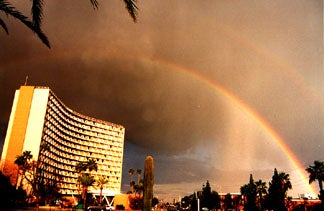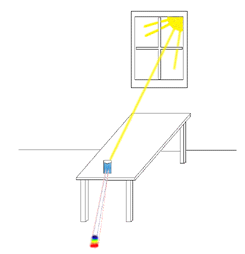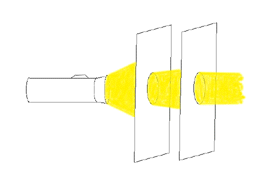Submodule 4: Rainbows
Steve Beeson, Arizona State University

If you ask, most people will say that a rainbow is "light going through raindrops" or
something to that effect. That is correct, but it's not the complete answer. In this lesson we will
learn how and why rainbows form and how you can make one yourself in the classroom.
At home, put a glass filled with water near the edge of a table that is bathed in sunlight or
some other parallel light source. As in the drawing below, a "rainbow", or spectrum, should appear on the floor near the glass.
In this case, the glass of water is acting like a prism and is dispersing the white light into its
many colors.
What if we could also make the water act like a mirror?
What do you think would happen if we shine the light on water in the flask?
What did you find? Did you see the "rainbow" on the table?
How could you test your hypothesis?
How would you explain what you observed, based on what you've learned in the Light & Optics Module?
Everyone has seen a rainbow. They are arguably one of the most beautiful displays of nature, and they seem to come in many different sizes, situations, and settings. But what is a rainbow?

Let's repeat our experiment with the water and the light.
This time, we'll use some materials from the Patterns lab. We'll need a powerful light source, an Erlenmeyer flask (a round-bottomed flask), water, and a large piece of
white cardboard.
*Remember: the beam should be as straight and undivergent as possible. You can achieve this by using a convex lens or two pieces of cardboard with medium-sized holes cut in them.

If you shine the light on the flask, will the spectrum be transmitted through the water and the glass and come out on the table or floor?
Try it with the flask and "turkey light box" provided in the lab.
If the spectrum could not be seen on the side of the flask opposite the light, where might the rainbow be forming?
 Modules
Modules
 Light & Optics
Light & Optics
 Submodule 4
Submodule 4
 Readings
Readings
 PiN Homepage
PiN Homepage
 ACEPT
ACEPT
 Glossary
Glossary
 Help
Help